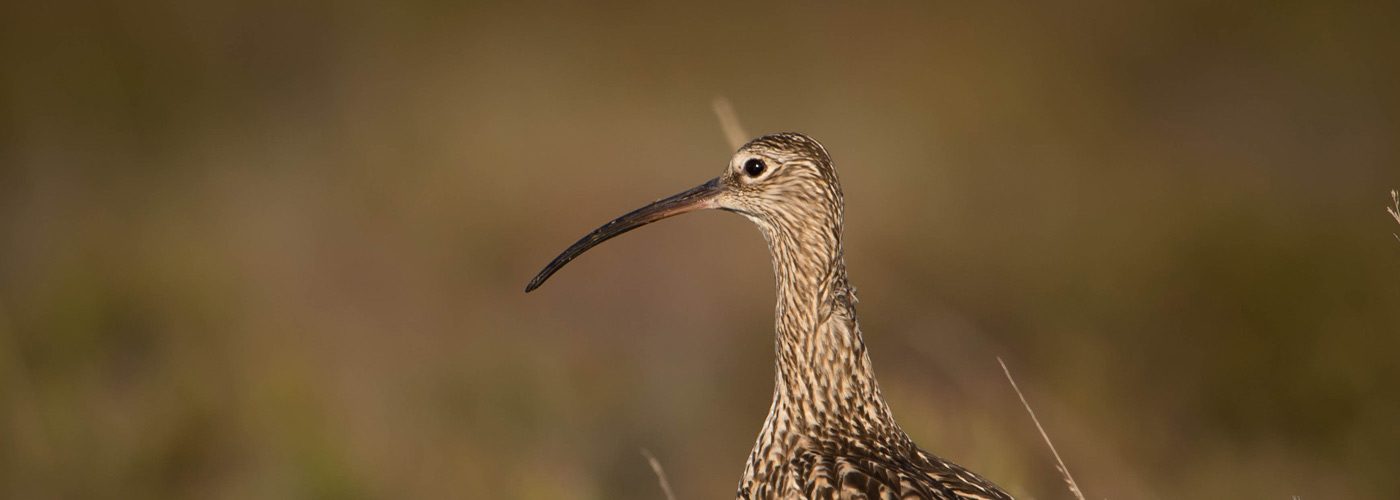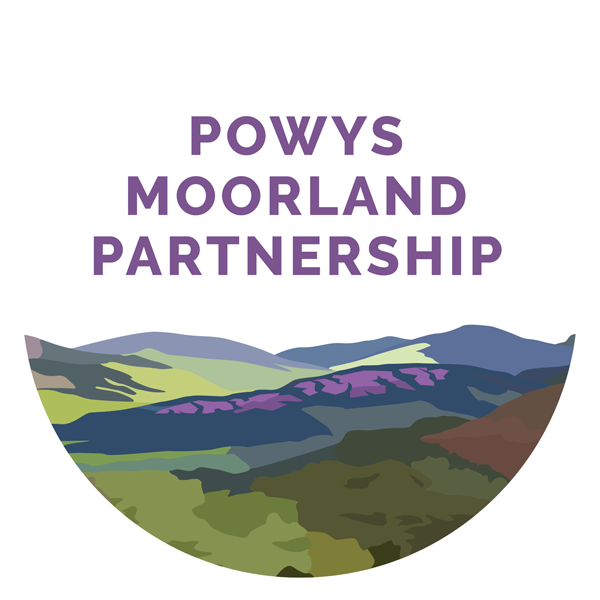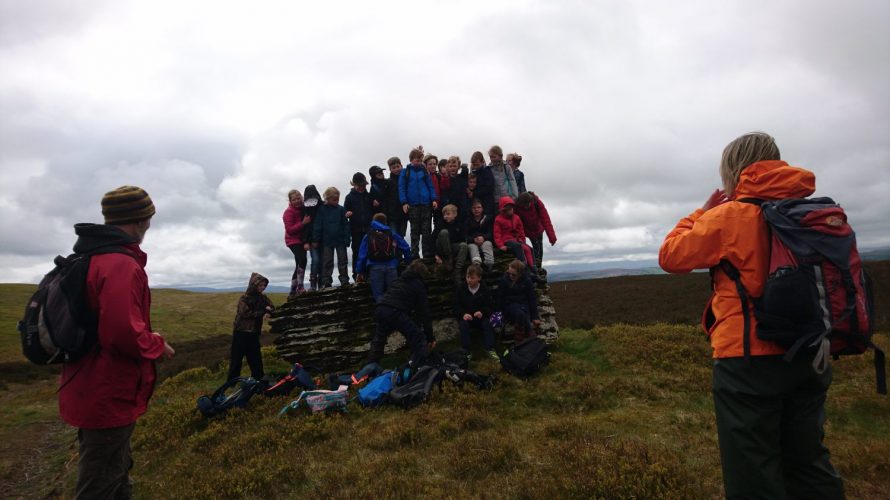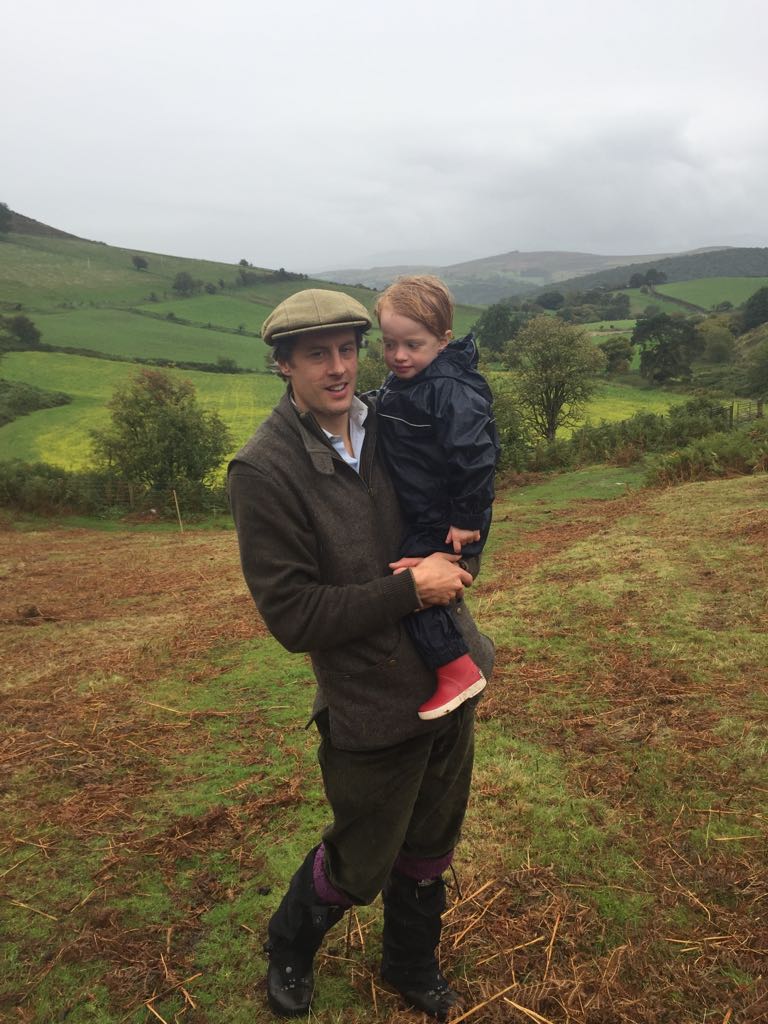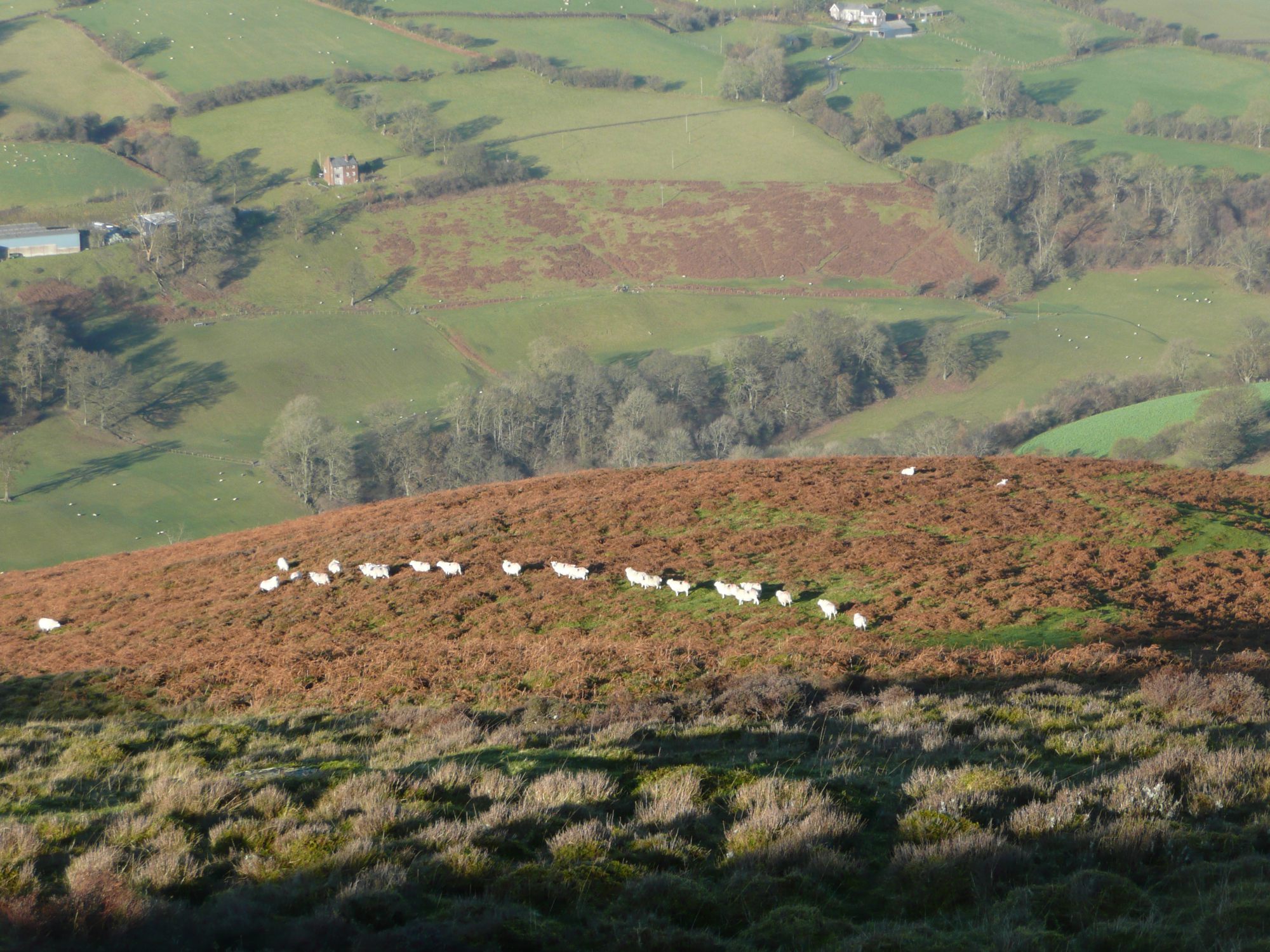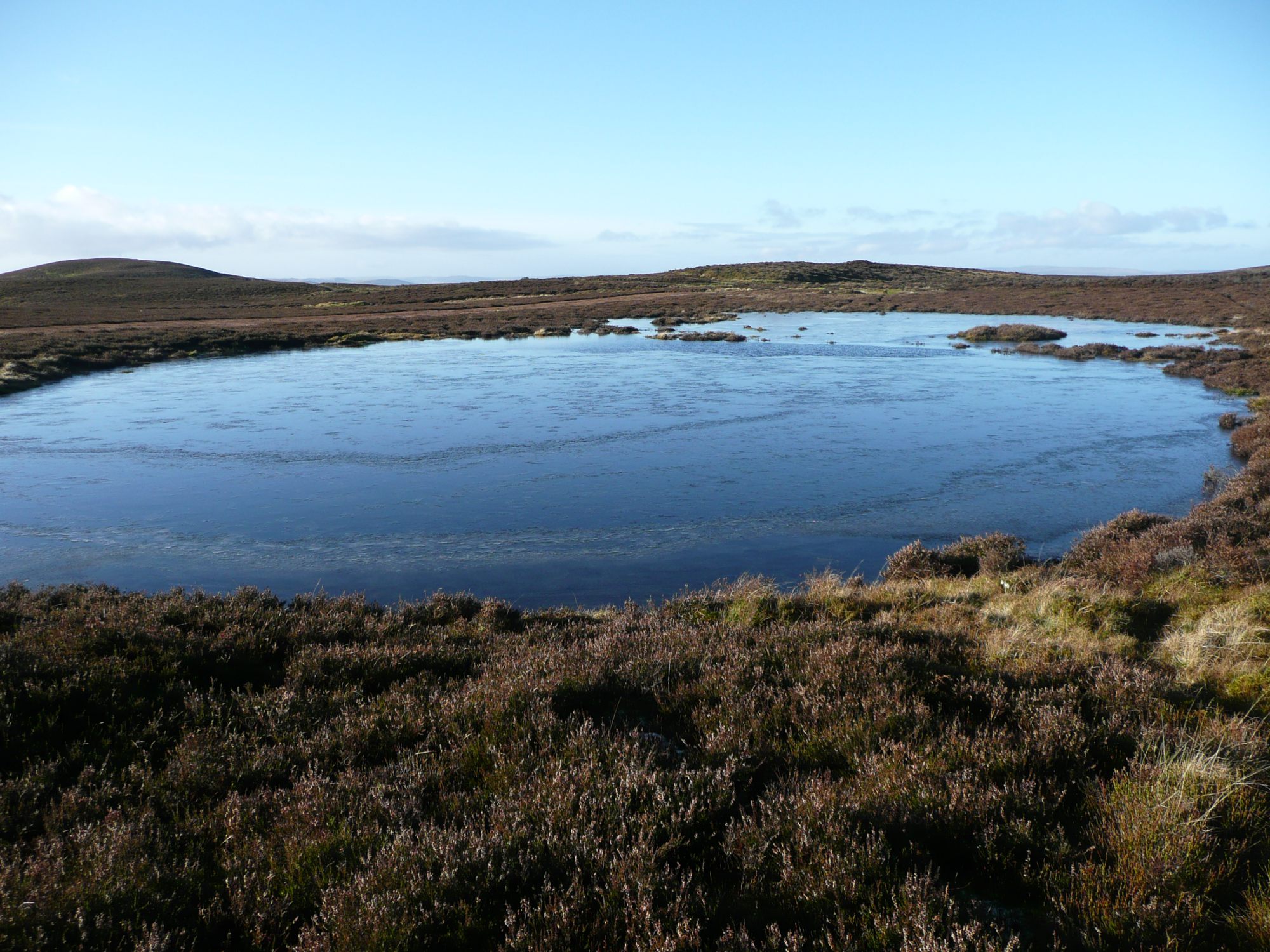On 25th June, BBC4 Farming Today‘s show about Controlling Mountain Hares in Scotland, Fenland farm report and Curlews featured a whole section about Curlew conservation in Wales and an interview of our very own Nick Myhill, farmer and conservation expert, working with Powys Moorland Partnership amongst other initiatives to protect the curlews through a range of actions, from habitat improvement to predator control. Listen to the show below.
The curlew’s population has dropped by 80% over the last 30 years with only about 50 000 pairs left nesting, among which 300 or 400 hundreds are located in Wales. RSPB Cymru suggests that farmer practices might be partly to blame. Nick Myhill explains that the modern agricultural practices are partly responsible for different reasons, but they’re not the only reason for that drop in numbers. A hundred years ago, the curlews would stay on the Moor where it lived the rest of the year to nest. Since then, potentially to escape predators or the public, they have started to move to hay fields. Modern agriculture has replaced hay-making by sillage, which is a much faster process that happens earlier in the year. The curlew needs effectively two months of peace in a mowing field, the four first weeks to incubate and the five after that for the chicks to be able to move around on the ground.
Huw Jones is one of the local farmers involved in the program to protect the curlews. His advice is for people to work together and be aware of the curlews, avoiding any topping and mowing while the birds nest in the fields. Huw also suggests that the structuring of farming could be partly responsible because costs of production have been going up so that farming entreprises might not have been as proactive as they used to be. But there is hope, if people are looking to be more sensible and work together.
Header photo by Jason Thompson.
Clyro school children out on local Powys moorland hearing the tales of the Mabinogion
Captivated by the tales of the Mabinogion – earliest prose stories of British literature – and re-enacting the tales while walking the stunning Powys landscape last week (Thursday, 3 May) made the day mystical and highly memorable.
“With four seasons in one day, we experienced a changing landscape throughout the day which seemed appropriate with the tales of the Mabinogion which draws upon the mystical word of the Celtic people intertwining myths, folklore, tradition and history,” says story teller Wayland Boulanger.
Teacher Caroline Phillips believes the day inspired the children and got them thinking about where the story might go. “They were so excited & interested to know what happened next as we walked on to another point of the hill.”
Many of the 26 children aged between 8-10 years live locally and pointed out their homes as we walked across Llanbedr hill near Painscastle.
The day started with one of the moorland managers explaining the work of the project to protect the rare ground nesting birds which are in serious decline.
With over 200 children out on the moor so far, the aims of the Powys Moorland Partnership (PMP) project is to restore the condition of the heather to encourage ground nesting birds back and help boost biodiversity. It is a three year project which ends next spring.
It’s a collaborative, landscape scale project engaging with local farmers and all stakeholders to make better links between our natural resources and the well-being of the people.
Catherine Hughes is the project facilitator for the PMP: “There’s nothing more powerful than getting children outside to see for themselves these magical landscapes grazed by sheep which are so important in providing us with so many benefits. With seventy percent of our drinking water coming from the uplands filtered by the vast amounts of mosses, and slows down the flows downstream, and also stores vast amounts of carbon.
Restoring Moorlands on BBC Wales
The Powys Moorland Partnership was the subject of an episode of Country Focus with Rachel Garside on BBC Wales last Sunday morning. Country Focus is a programme on BBC Wales serving everyone living in the countryside and tackling issues affecting them. In this episode Rachel Garside visited the moors with Catherine Hughes and Nick Myhill to understand the aims of the PMP.
You can listen back to the programme below.
Big Farmland Bird Counts – creating year-round habitats
PMP has carried out a number of counts on various farms joining the moorland this January/February where Hay and Clyro primary children helped gather the data.
PMP project facilitator Catherine Hughes comments: “Although we keep hearing about the decline of so many bird species it’s exciting for kids to see that once you start looking closely and being still for 30 minutes with binoculars to hand you start seeing more than you think.
These events, sponsored by the NFU this year, raises the awareness of the efforts farmers put in to helping wildlife and what simple practices can be put in place to help recover nesting areas.”
Matt Goodall is the Game & Wildlife Conservation Trust advisor. He stressed the need to help the birds throughout the bare months known as the hunger gap – January/February, March by planting mixed variety – preferable using kale and quinoa – cover crops in appropriate areas of the fields to give cover and food to the birds and insects to feed the chicks. Ideally we want year round habitats to help all our birds get the best start.
Results will be issued on our website.
Breeding season – time for reminders!
The PMP is putting a leaflet together with our key collaborators, the farmers, graziers, BHS, Ramblers, Powys CC etc. so that we help people use our landscapes responsibly especially as we approach the breeding season. Dog walkers are reminded that keeping dogs under close controls and sticking to the paths is critical at this time of the year if we are maximise our breeding successes. This applies to birds and lambs who need all the protection they can get this spring.
Maureen Lloyd – secretary of the graziers and one of the gamekeepers Huw Lavin will provide their contact details on the leaflet so that people can have a contact while out on the moor.
The economics of the Powys moorlands
The topic of what the British uplands should look like in 100 years time is much discussed and everyone has a view.
The visible threat to our existence posed by climate change when combined with some fundamental changes to the subsidy system post Brexit means that policy makers are very focused on what landscapes can do for the greatest possible good. This creates inevitable tensions from a vocal constituency promoting ‘rewilding’ who seek to end many of the ‘traditional’ uses of moorland landscapes.
In the case of the Powys moors, can farming and recreation compliment the ability for these hills to process rainfall, store carbon, clean the air and host globally rare habitats and bird species? In short, is the way these moors are managed making the most of what this natural environment can do for society? Public money will only go towards public goods in the widest possible sense.
We believe that with the right resources and focus, a sensible balance can be struck. The catch, of course, is that new funding is required to achieve this outcome. This is because nothing is free and the current Government funding ends in 2020.
The PMP tasked the experts, Economics For The Environment (EFTEC), to compare the total value of public goods performed by the Powys moors with what they cost to maintain over a 25 year period.
The benefits that provide actual revenues (money from food production and shooting) are far less than the ongoing management costs that sustain these services. But, since the sum total of all these public goods is a large number – it would cost society £13m or £500k annually to secure equivalent benefits if the moors were not there – it’s surely worth securing these benefits and also increasing them.
As custodians of the Powys moors we strongly advocate the need for full time moorland keepers to work with the graziers to prevent wildfires, promote biodiversity and prevent any more loss of rare heather habitat. Visitors come for the great views but the management that we fund gives these lands their uniqueness with heather and rare species more viewable here than almost anywhere else in Wales.
But, to bring your horse, dog, friend, motorbike, 4×4 to this ground is free. Managing the landscape to make it last, mitigate climate change and produce public goods is not free. There is a large gap here. By valuing its Natural Capital the PMP hopes to add some facts and figures to inform future public policy and to slowly narrow the funding gap to sustain the ongoing love that these lands deserve.
Preserving our semi-feral Welsh ponies
With no stallion on the hill for almost eight years, and some of the mares – out grazing all year – are now in their 20s. The owners of these wonderful ponies selected a few of them to put into foal in 2018. Registered with the Welsh Pony & Cob Society, these semi-feral section A mares come from Pendre (Pendre Farm), Painscastle (Newhouse Farm) and Llewetrog (Llewetrog Farm) and are monitored by the Llandeilo Graban Hill Pony Improvement Society.
“This predominately closed herd is in desperate need for youngstock to carry on the bloodlines which go back generations,” says Lisa Lloyd, whose family has a long association with the ponies at Pendre.
”They are an intrinsic part of the landscape, culture and heritage and are irreplaceable,” says Lisa, who explained that at the last gathering in May 2018 they selected 13 mares and put them – funded partly by the PMP – to a leased palomino section A stallion, Afon Carousel (Criccieth Arwr x Afan Caroline) from the Afan Stud, Llanafan, to run with the mares for six weeks.
Photo kindly taken by Kerry Hendry
Colin Thomas is vice chairman of the WPCS and has worked in an advisory capacity with the breeders who graze Ireland Moor, which according to him ‘is one of the most picturesque landscape in Wales’. He is delighted that we can expect some foals this spring. He comments:
“These semi-feral equines found in the hills and valleys of Wales are descendants from the ancient celtic horses which have made a huge contribution to the cultural landscape of Wales through the millennia, encapsulated today by the continued effort of breeders who against considerable odds have maintained this most iconic of the Welsh breeds.”
“The hills of Wales and the borders were alive with hill pony herds of wild, hardy animals left virtually to fend for themselves, ensuring that only the hardiest survived. Nature’s doctrine of ‘survival of the fittest’ led to the natural selection of the Welsh Mountain pony; alert, robust, adaptable, durable, clever and graced with beauty.
“The hills and mountains of Wales contain some of the most attractive countryside in the world and have evolved and shaped that way because of generations of pony breeders and farmers.”
“Over many generations their fortunes have ebbed and flowed in tune with the economic and environmental dynamics of the time, but it is a testament to their tenacity and fortitude that in spite of a whole variety of negative pressures, pony breeding has still survived. The WPCS still promotes and provides premium grants on an annual basis for hill stallions and foals.”
“It is essential that these ponies breed on this area to preserve and maintain the gene pool. Their contribution to conservation, habitats and wildlife is well noted by senior ecologists and is also vital to this unique way of life. “I sincerely hope that breeding ponies on their natural environment will continue and flourish,” concludes Colin.
What does a sustainably managed moor look like?
That’s a question which The Powys Moorland Partnership hopes to provide some answers to.
There is of course no one model of sustainable land use, things will look different in different places. However three moors in mid-Wales provide the setting for a three year Welsh Government and EU funded project exploring how to achieve a workable and long-term balance between nature and people, including those who earn a living from the moors and those who enjoy them for recreation. It is the classic sustainable development mix of environment, economy and society.
The initiative includes Ireland Moor, Beacon Hill and Bal Bach, and its primary focus is on the aim of reversing the decline of our iconic moorland bird species such as the red grouse, curlew, lapwing, and golden plover by restoring their heather moorland habitats and employing keepers. The purpose of the Sustainable Management Scheme is to support collaborative landscape scale projects taking action to improve the resilience of our natural resources and ecosystems in a way that also delivers benefits to farm businesses and rural communities.
Collaboration is identified as the key to success and much of the effort in the project is on bringing the various interests together to discuss and agree the best way forward, so that everyone gets what they need from the moors. This is done through a series of public events and surveys, to gather the knowledge and opinions of those who use, own, farm, manage and visit the three moors.
When it comes to restoring the biodiversity on these moors, a huge amount of monthly data is being recorded to help the landowners to quickly spot the key areas in which to focus their attention. Judging by the numbers of foxes and corvids being removed, predator control is clearly a key priority. However, maintaining the heather with the invasion from gorse and bracken is also a big challenge. Following advice from Dick Bartlett of British Moorlands, the project has begun to focus upon customised heather cutting and burning techniques which are designed to offset the impact of high raptor densities.
Catherine Hughes is the Project Manager and much of her time is taken up speaking with the various interests from owners, keepers and graziers to recreational and tourism interests. Catherine says “By engaging with all interested parties we can start to agree on the 80% of what we want our landscapes to look like in the future, but it takes time and commitment to get the messages across. This collaboration is a new initiative therefore we have to keep involving all interested parties and keep up the momentum and strengthen the story as we proceed and more importantly demonstrate what the outcomes are through restoration of the ground. Engagement and more engagement and constant communication is key. School visits are hugely positive especially when the kids are so enthusiastic and feel able to ask any question they like particularly as it is their community. By having gamekeepers and graziers conduct the visits our aim is to find solutions where our landscapes have a bigger and better story to tell. The children clearly enjoy having gamekeepers and graziers explain what and why they do what they do. It really can’t be taught in the classroom. It also potentially inspires them to think of what they could get involved with in the countryside as a career.”
Our aim is to get 500 local children up on the moors over the three years and develop new ways through a variety of citizen science, arts, music etc to convey the beauty of our landscape and get them to help us celebrate their importance. We need the children to feel an ownership of them and so far it has been fantastic and the message from these kinds of events get quickly communicated to a much wider audience. The moorland story is complex with so many different aspirations but we are engaging with as many stakeholders as possible to see if ultimately we can boost the biodiversity and create quality jobs to bolster the rural economy and in the process build resilience into our Welsh moorlands.”
Additionally, the Project is collating data from the moors themselves. A baseline natural capital evaluation has been carried out by eftec. Some simple citizen science is also underway, with quadrats having been marked out so that measurements of percentage cover of plant species can be assessed, and vegetation height can be measured twice a year. In addition, some fixed-point photography has also been undertaken. All of these methods will enable progress to be measured in due course.
The owner of Ireland Moor, Will Duff-Gordon, is particularly interested in restoring some grouse shooting to the moors in Powys. Will has witnessed the steady decline in the health of these moors during his lifetime and he decided to kick start a much needed turnaround. In order to do this, it made sense to secure government support then begin an ambitious project that will stimulate investment in 20,000 acres of Powys moorland.
“Through multiple meetings and conversations we hope to create a better awareness of the public benefits that are performed by these moorland habitats. The end goal is that the land can continue to be enjoyed by many but within the boundaries of what is good for the land and its rare species. The public, farmers and landowners need to help the land become resilient to ever greater public use and provide ongoing funding for full time moorland keepers. We believe it’s possible to achieve this and with an excellent team of keepers, advisors, farmers and local facilitators we are well positioned. The Welsh Government have been excellent collaborators so far and we feel a great sense of duty to repay their faith and prove that employing moorland keepers should be the key driver to preserve and enhance the stunning mid Welsh moors”.
The Heather Trust is very pleased to be involved with the Partnership. We are providing the training element of the project, and we are also providing some administrative support to Catherine Hughes to help her pull the various threads together.
So far we have provided events on Integrated Management and Bracken Control, enabled a keeper exchange between Powys and Aberdeenshire, and we were able to organise an advisory visit from Dick Bartlett of British Moorlands Ltd.
We also have a best practice burning event planned for the Autumn and more to come next year. Our events have both a theory and a practical element to them and have been very well attended, with lots of good discussion, sharing of ideas and positive feedback.
For the bracken management day, we were able to draw on the expertise of Heather Trust President, Rob Marrs Agronomist Jonathan Harrington and Welsh Water, as well as pull in a range of companies providing bracken management equipment for practical demonstrations on Beacon Hill.
David Thomas manages Beacon Hill which is owned by the Crown Estates. Beacon Hill was once a very important Grouse moor in the nineteenth century attracting a lot of people from all over the UK and beyond. You can see the remains of the Victorian Shooting lodge on the hillside today and there was even a railway station to bring guests right up to the moor by train. David has been working on restoring the heather since 2014 and liaising closely with the graziers on the common so that a balance between heather, grazing and bracken can be achieved. David is already seeing the fruits of his work with more red grouse appearing along with other waders but the challenge of predators is very apparent. “Finding the balance will need more resources,” says David, “and more collaboration by all interested parties. With our permitted burning period being two weeks shorter in Wales compared to England and Scotland, we have a number of things against us so closer collaboration with WG and NRW is crucial.”
Our autumn event will be on Llantony Moor which is owned by Arwyn Davies and seven other partners – all from the medical profession. Bought almost 20 years ago Arwyn and his team’s interest in being part of the Partnership stems from their love of this moor with its abundance of heather not forgetting the spectacular views across the Brecon Beacons and beyond.
“As we have grown older the management of Bal Bach has meant older heather is evident which has impacted on the bird life.We want to keep the energy going and are proud to be part of the PMP which is helping us manage the moor with rotational cuts and burns along with keeping predators in check. We love our days on the moor in August/September.
It is a social event where we shoot a few grouse and enjoy a hearty picnic.”
The three years of the pilot is not long in terms of moorland management. To see these moors truly offer a sustainable mix of outputs will no doubt take longer, but it is an important start that is enabling real and important progress to be made. As the UK moves towards a future for land management that is no longer supported by the Common Agricultural Policy, the Partnership is testing out the natural capital balance that is prevalent in government thinking at the moment. Their efforts now should stand them in good stead for the rural policy that replaces the existing farm support and rural development system.
History of Red Grouse Shooting
A brief history of red grouse shooting 1900-1960s
As indicated by the graphs below, from 1900 to the end of the Second World War Powys enjoyed large numbers of grouse. The Beacon hills for example had so many grouse that the owners created a shooting lodge and train station to help people from London to enjoy its sport. It has a section of heather known to many as the Millionaire’s Mile in honour of the grouse drive over this area.
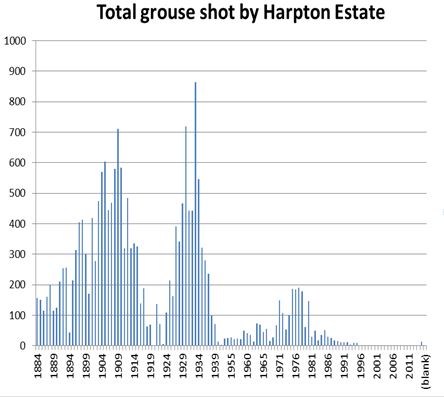
1960s – 1990s
After the War, a great deal of Welsh heather was lost due to conifer planting and the emergence of the Common Agricultural Policy which paid farmers according to stock numbers. Raptor numbers started to increase at the end of this period and grouse eaters like buzzards and hen harriers became protected species in the early 1980s.
By 1990 Ireland Moor and Gladestry were the best areas for grouse, but the number of birds shot and the number of moors with keepers had declined sharply. There were just ten keepered moors in Wales in 1990, with only 640 birds shot that summer.
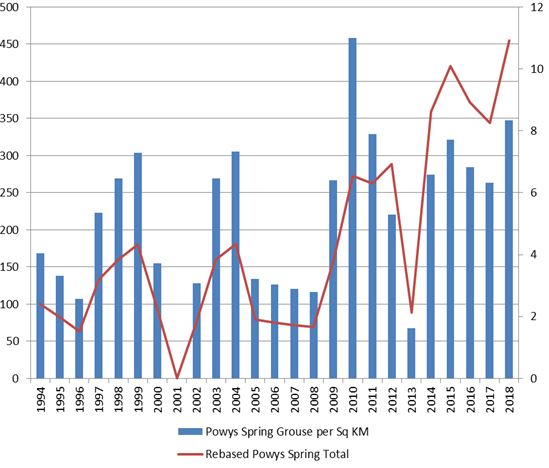
2010-present
By 2010 there was not a single moor in Wales with a full-time grouse keeper.
The catalyst for change came in 2015 when the Welsh Governments Nature Fund sprinkled seed funding across nine moors, leading to keepers being employed to bring their management expertise to these neglected areas.
Thanks to the combination of Government support and private investment there are currently five full-time grouse keepers in Powys.
Aims for the future
As this Game & Wildlife Conservation Trust graph shows, red-grouse numbers in northern England have recovered well since 1990. In Wales this has not yet happened. Although the aim is not to achieve the densities seen in northern England, we are committed to creating a sustainable surplus of numbers so that we can support shooting of this economically important bird. This will require sensitive land and predator management with the emphasis being on creating sustainability for all – including flora, fauna, human, and community.
The spring count
Thanks to many recent years of hard work from the moorland keepers, the recent counting shows that the pairs of grouse this spring are more numerous than they have been since the 1970s.
The area counted is the moors above Painscastle (Ireland Moor) along with Gladestry, Gwaunceste and Beacon hills.
With that said, the percentage of the grouse that died during the winter due to predation and natural causes was over 40% across all Radnorshire moors – the yardstick to aim for is 30%.
This chart shows the grouse per square km (per 100 hectares) and an index of the increase in spring grouse since 1994.
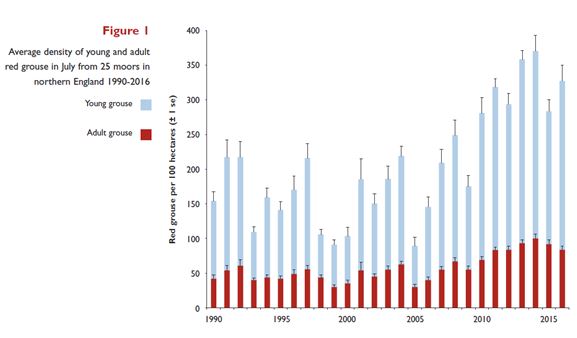
Keep in touch, get involved.
We will be putting on various events over the next 12 months. If you would like to get involved, have some ideas please contact Catherine on urmyc.sdnalroomsywop@tcatnoc
